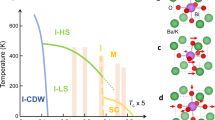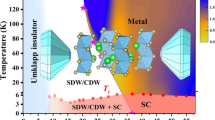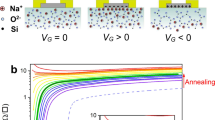Abstract
The silicon clathrates—materials composed of metal-doped Si20 dodecahedra—were identified as the first superconductors based on pure silicon networks1,2. The mechanism of superconductivity in these materials can be obtained by studying their phonon modes, as modified by isotope substitution, and specific-heat measurements. Here, we present experimental studies that provide strong evidence that superconductivity in Ba8Si46 is explained in the framework of phonon-mediated Bardeen–Cooper–Schriefer theory. Analyses using the McMillan approximation3,4 of the Eliashberg equation indicate that the superconducting mechanism is in the medium coupling regime, but at the high-end limit. The large density of states at the Fermi level, which arises from hybridization of the Si20 cluster and Ba orbitals, is responsible for the unexpectedly high superconducting temperature. The temperature evolution of the specific heat unambiguously shows that this is an s-wave symmetry superconductor.
This is a preview of subscription content, access via your institution
Access options
Subscribe to this journal
Receive 12 print issues and online access
$259.00 per year
only $21.58 per issue
Buy this article
- Purchase on Springer Link
- Instant access to full article PDF
Prices may be subject to local taxes which are calculated during checkout



Similar content being viewed by others
References
Kawaji, A., Horie, H., Yamanaka, S. & Ishikawa, M. Superconductivity in the silicon clathrate compound (Na,Ba)xSi46 . Phys. Rev. Lett. 47, 1427–1429 (1995).
Yamanaka, S., Enishi, E., Fukuoka, H. & Yasukawa, M. High-pressure synthesis of a new silicon clathrate superconductor Ba8Si46 . Inorg. Chem. 39, 56–58 (2000).
McMillan, W.L. Transition temperature of strong-coupled superconductors. Phys. Rev. 167, 331–344 (1968).
Carbotte, J.P. Properties of boson-exchange superconductors. Rev. Mod. Phys. 62, 1027–1157 (1990).
Bednorz, J.G. & Müller, K.A. Possible high Tc superconductivity in the Ba-La-Cu-O system. Z. Phys. B Condens. Matter 64, 189–193 (1986).
Jèrome, D., Mazaud, A., Ribauld, M. & Bechgaad, K. Superconductivity in a synthetic organic conductor (TMTSF)2PF6 . J. Physique Lett. 41, L95–L98, (1980).
Hebard, A.F. et al. Superconductivity at 18 K in potassium-doped C60 . Nature 350, 600–601 (1991).
Tanigaki, K. et al. Superconductivity at 33 K in CsxRbyC60 . Nature 352, 222–223 (1991).
Tanigaki, K. et al. Superconductivity in sodium- and lithium-containing alkali-metal fullerides, Nature 356, 419–421 (1992).
Yamanaka, S., Hotehama, K. & Kawaji, H. Superconductivity at 25.5 K in electron-doped layered hafnium nitride. Nature 392, 580–582 (1998).
Nagamatsu, J., Nakagawa, N., Muranaka, T., Zenitani, Y. & Akimitsu, J. Superconductivity at 39 K in magnesium diboride. Nature 410, 63–64 (2001).
Bourne, L.C., Zettle, A., Barbee, T.W. III & Cohen, M.L. Complete absence of isotope effect in YBa2Cu3O7 . Phys. Rev. B. 36, 3990–3993 (1987).
Williams, J.M. et al. Organic superconductors new benchmarks. Science 252, 1501–1503 (1991).
Ebbesen, T.W. et al. Isotope effect on superconductivity in Rb3C60 . Nature 335, 620–622 (1992).
Ramirez, A.P. et al. Isotope effect in superconducting Rb3C60 . Phys. Rev. Lett. 68, 1058–1061 (1992).
Fuhrer, M.S., Cherrey, K., Zettle, A., Cohen, M.L. & Crespi, V.H. Carbon isotope effect in single-crystal Rb3C60 . Phys. Rev. Lett. 83, 404–407 (1999).
Tou, H., Maniwa, T. & Yamanaka, S. Superconducting characteristics in electron-doped layered hafnium nitride: 15N isotope effect studies. Phys. Rev. B 67, 100509 (2003).
Petrovic, C. et al. Boron isotope effect in superconducting MgB2 . Phys. Rev. Lett. 86, 1877–1899 (2001).
Haller, E.E. Isotopically engineered semiconductors. J. Appl. Phys. 77, 2857–2878 (1995).
Takyu, K., Itoh, K.M., Oka, K., Saito, N. & Ozhogin, V.I. Growth and characterization of the isotopically enriched 28Si bulk single crystal. Jpn J. Appl. Phys. 38, L1493–L1495, (1999).
Fang, S.L. et al. Raman scattering from vibrational modes in Si46 clathrates. Phys. Rev. B 57, 7686–7693 (1998).
Herrmann, R., Tanigaki, K., Kawaguchi, T., Kuroshima, S. & Zhou, O. Electronic structure of Si and Ge gold-doped clathrates. Phys. Rev. B 60, 13245–13248 (1999).
Yokoya, T. et al. Electronic structure and superconducting gap of silicon clathrate Ba8Si46 studied with ultrahigh-resolution photoemission spectroscopy. Phys. Rev. B 64, 172504 (2001).
Saito, S. & Oshiyama, A. Electronic Structure if Si46 and Na2Ba6Si46 . Phys. Rev. B 51, 2628–2631 (1995).
Acknowledgements
The authors thank V. I. Ozhogin for supplying 30Si and T. Atake for discussion of specific heat. We also wish to thank the staff members at SPring-8, Japan (beamline BL02B2 and BL25SU) for their support and to express our appreciation for the use of the facility of high-energy beam. Institute of Material Research No129-2003 is also acknowledged for support of its facility usage. Financial support from the nanotechnology proposals of the both beam lines from SPring-8 is also greatly appreciated. The project was supported by a Grant-in-Aid from the Ministry of Education, Sport, Science and Culture of Japan, No. 13304031 and 14076215. This work has been supported by PRESTO and CREST of JST (Japan Science and Technology Corporation).
Author information
Authors and Affiliations
Corresponding author
Ethics declarations
Competing interests
The authors declare no competing financial interests.
Rights and permissions
About this article
Cite this article
Tanigaki, K., Shimizu, T., Itoh, K. et al. Mechanism of superconductivity in the polyhedral-network compound Ba8Si46. Nature Mater 2, 653–655 (2003). https://doi.org/10.1038/nmat981
Received:
Accepted:
Published:
Issue Date:
DOI: https://doi.org/10.1038/nmat981
This article is cited by
-
Clathrates join the covalent club
Nature Materials (2003)



